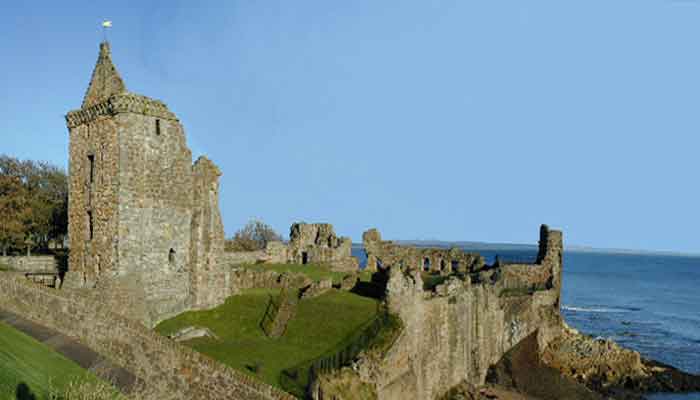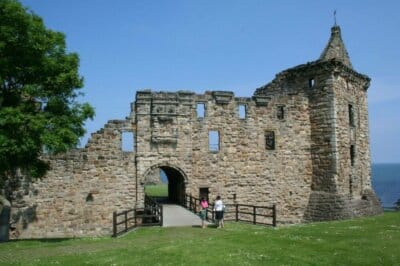Almost nothing is left of the original St Andrews Castle built by Bishop Roger (1189-1202).

It was Bishop Walter Trail (1385-1401) who started the rebuilding process after considerable destruction during the Wars of Independence.
However, in 1337 the Scots destroyed much of it to stop it from falling into English hands. Most of what remains today is from that period.
St Andrews Cathedral
Although the castle had close links with the nearby St Andrews Cathedral, it was St Andrews Castle that became the main residence of the bishops and archbishops of St Andrews.
As such it became the main administrative centre for the church in Scotland.
Throughout the years the castle often played host to some of Scotland’s best-known historical figures, some more welcome than others.
University of St Andrews
Archbishop James Beaton (1521-39), for example, one of the early chancellors of the University of St Andrews (Scotland’s first university), worked hard to strengthen the castle defences, in particular the building of two large circular gun towers and extra gun emplacements.
Cardinal David Beaton
Following James Beaton’s death, he was succeeded by his nephew David Beaton. Beaton, educated initially at the universities of St Andrews and Glasgow, was sent at the age of 16 to study law in Paris where he became immersed in politics at the French court.

Returning to Scotland he was at first appointed Abbot of Arbroath Abbey in 1522. By 1539 he had become Archbishop of St Andrews and in the same year was made a cardinal by Pope Paul III.
Prominent family connections and a growing influence with Mary of Guise, mother of Mary Queen of Scots made him the most powerful churchman in the land.
George Wishart
Beaton zealously pursued those he regarded as Protestant “heretics” including the preacher George Wishart, confidant and mentor of John Knox.
In 1546, Wishart was imprisoned in the castle’s infamous bottle dungeon before being burned at the stake outside the castle.
John Knox
In retaliation, a group of Protestants, which included John Knox, entered the castle, murdered Beaton and hung his naked body over the castle ramparts before later preserving it in a salt barrel.
Related articles
- Scotland’s earliest monarchs
- Marquis of Montrose
- Dunbar history
- 11 Castles in Edinburgh and nearby to explore
In no hurry to leave they occupied the castle for a year before being forced out by French soldiers supporting the Earl of Arran, the Scottish Regent. Among the prisoners taken from the castle and sent as slaves to the French galleys was John Knox.
Archbishop John Hamilton
The final resident in St Andrews Castle was Archbishop John Hamilton remembered for building the ‘Hamilton Facade’, the new entrance front.
Hamilton an opponent of the Protestant Reformation and supporter of the Catholic Mary Queen of Scots was hanged in 1571.
With his death and the abolition of episcopacy in 1592, the castle no longer served its purpose and over the following centuries, it fell into ruin.
St Andrews Castle is the perfect day trip from Edinburgh
For information on opening hours, cost of entry and other tips to help you plan your visit, go to the official castle website.